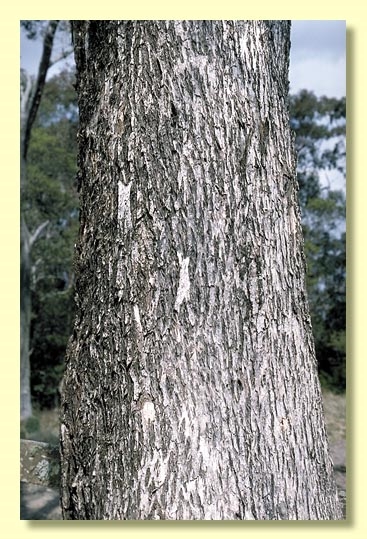Euclid - Online edition
Eucalyptus quadrangulata
Eucalyptus | Symphyomyrtus | Maidenaria | Euryotae | Globulares | Remanentes
Eucalyptus quadrangulata H.Deane & Maiden, Proc. Linn. Soc. New South Wales 24: 451 (1899).
T: New South Wales. Hill Top, Box Knob, J.H. Maiden s.n., January 1896; lectotype: NSW [NSW317818], isolectotype: NSW [NSW317817, NSW317819 & NSW317820]; fide Bean, A.R., Telopea 12(3): 318 (2009).
Bark rough to small branches, box-type, grey or whitish.
Juvenile growth (coppice or field seedlings to 50 cm): stem square in cross-section and winged, non-glaucous; juvenile leaves opposite and sessile from seedling to sapling stage, lanceolate, 7–15 cm long, 1.3–3.5 cm wide, base amplexicaul, discolorous, green.
Adult leaves alternate, petiole 1.3–2.5 cm long; blade lanceolate to falcate, 10.5–19 cm long, 1–2.2 cm wide, base tapering to petiole, margin toothed due to lenticels, concolorous, glossy, green, side-veins greater than 45° to midrib, densely reticulate, intramarginal vein parallel to and just within margin or remote from it, oil glands mostly island.
Inflorescence axillary unbranched, peduncles 0.9–1.2 cm long, buds 7 per umbel, usually sessile, rarely with pedicels up to 0.2 cm long. Mature buds ovoid to fusiform, 0.4–0.7 cm long, ca 0.3 cm wide, green, smooth, scar present, operculum conical, stamens irregularly flexed, anthers cuboid to oblong, versatile, dorsifixed, dehiscing by longitudinal slits (non-confluent), style short, stigma blunt, locules 3 or 4, the placentae each with 4 vertical ovule rows. Flowers white.
Fruit sessile or rarely with pedicels to 0.2 cm long, obconical, 0.4–0.5 cm long, 0.4–0.6 cm wide, disc narrow, descending to level, valves 3 or 4, enclosed.
Seeds brown, 1.2–2 mm long, ovoid to flattened-ovoid, lacunose, dorsal surface shallowly pitted, hilum ventral.
Cultivated seedlings (measured at ca node 10): cotyledons bilobed; stems square in cross-section and winged, not glaucous; leaves opposite and sessile for many nodes, lanceolate, 7–11 cm long, 1.5–3.5 cm wide, amplexicaul, margin denticulate, apex pointed, discolorous, slightly glossy, green above, paler beneath.
Flowering has been recorded in February, March and April.
A small to medium-sized forest tree, scattered but relatively widespread throughout the Tablelands of New South Wales, north from Bundanoon on the eastern slopes of the Southern Tablelands through to the eastern fall of the Central and Northern Tablelands, with an extension to high country near Cunningham's Gap in far south-eastern Queensland. While Eucalyptus quadrangulata has typical box bark, it is unrelated to the box species (in section Adnataria) and may be distinguished from them by the axillary inflorescences and versatile anthers. E. quadrangulata has long glossy green adult leaves, small buds in clusters of 7, small obconical fruit and ovoid to flattened-ovoid seed. A curious feature of the adult leaves of E. quadrangulata is the presence of marginal protuberances called lenticels.
It is most closely related to the smooth-barked E. denticulata , which also has the leaf lenticel character, and to E. nitens, which has lacks lenticels. These 3 species all have sessile, small buds in 7s, fruit with a descending disc and juvenile leaves opposite and sessile for many nodes, on stems that are square and winged.
In the classification of Brooker (2000) Eucalyptus quadrangulata belongs in Eucalyptus subgenus Symphyomyrtus section Maidenaria, a large group of species more or less restricted to south-eastern Australia, characterised by bilobed cotyledons, simple axillary inflorescences, buds with two opercula, stamens with versatile anthers and flattened seeds with a ventral hilum. Within this section, E. quadrangulata, E. denticulata and E. nitens belongs in series Globulares subseries Remanentes, united by the features outlined above.
Lenticels on the margin of adult leaves are uncommon in Eucalyptus but can be seen in E. quadrangulata and E. denticulata (in subgenus Symphyomyrtus section Maidenaria), E. incrassata (subgenus Symphyomyrtus section Dumaria), E. eugenioides (subgenus Eucalyptus section Capillulus), see Neish, P.G. et al., (1995) for details of anatomy.













